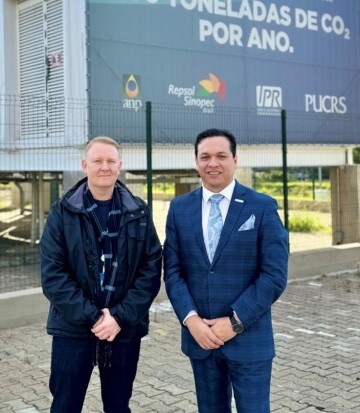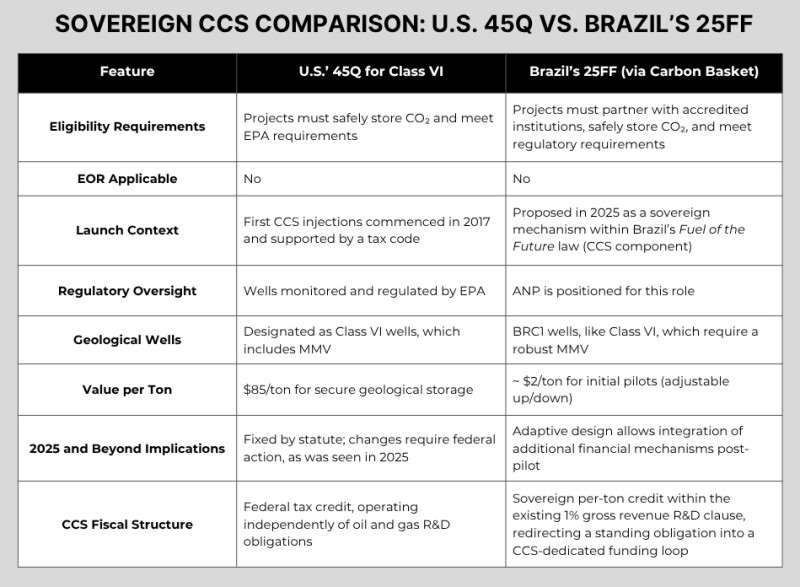While much of the world turns to carbon trading or blanket subsidies to scale carbon capture, Brazil holds a distinct national mechanism, one that enabled the deployment of South America’s first direct air capture (DAC) facility in Porto Alegre, personally visited by the author. The mechanism draws from a legally mandated 1% gross revenue research and development (R&D) clause administered by Brazil’s regulator, Agência Nacional do Petróleo, Gás Natural e Biocombustíveis (ANP). This establishes a total investment obligation under which oil and gas concessionaires must apply annually 1% of gross production revenue, valued at more than $1.55 billion dollars over the past 2 years, toward national capacity building and knowledge dissemination through accredited institutions, resulting in technologies such as DAC.
This is now reinforced through Brazil’s 2024 carbon capture and storage (CCS) law, which underpinned 28% of global carbon dioxide (CO₂) injection in 2024 through enhanced oil recovery (EOR), with regulations advancing Brazil’s first-ever CCS well, an ethanol-to-CCS pilot, preparing for injection. Notably, this writing formally proposes directing part of the 1% to a “Carbon Basket,” supporting a modest sequestration credit, such as $2 per ton, for initial pilots, which can adjust up or down, with the above project and future ones serving as a potential testbed. The proposal draws from the US precedent of 45Q, which offers $85 per ton for verified storage (via point source capture without EOR), anchoring fiscal incentives to geological integrity.

A Hard Rewiring of Carbon Incentives With 25FF
Unlike 45Q, which is structured through the US tax code, the Carbon Basket converts Brazil’s existing R&D clause into a sovereign mechanism for value-based credits. Each qualifying project trains Brazil’s “connective tissue” across domains—operational, legal, technical, academic, private, and public sectors—including the very system that gave rise to it through the 1%.
Brazil can benefit by mirroring what proved decisive for CCS deployment in the US through a sovereign fiscal regime anchored by monetizing verified storage. The US offers the 45Q sequestration credit, valued at $85 per ton and tied to US Environmental Protection Agency (EPA) designated Class VI wells. Brazil’s regulation, as proposed here, should establish a comparable standard: a Brazilian Category 1 (BRC1) well, used solely for sequestration without EOR via point source capture. Within this same proposal, a per-ton sequestration credit—25FF—would start at $2, earned only upon verified geological storage. Both BRC1 and 25FF are original terms introduced by the author, with 25FF standing for 25 (representing 2025) and FF (Fuel of the Future, the legal framework housing Brazil’s CCS law).
25FF is not designed to duplicate 45Q; rather, it is an adaptive tool aligned with Brazil’s institutional architecture and learning-based R&D clause. Within this adaptive framework, the Carbon Basket serves as the umbrella under which 25FF credits operate, ensuring that the sovereign credit structure remains tied to Brazil’s fiscal and regulatory architecture. Imperatively, much like Class VI, 25FF in any shape requires regulation supported by a measurement, monitoring, and verification (MMV) plan, which is the heart of a safe, operational, sustainable, and bankable CCS project. It is also key for informing regulations still being developed to scale projects.
The Funding Mechanism in Action
Brazil’s pre-existing 1% gross revenue R&D clause, which can be applied to the Carbon Basket, administered by ANP, establishes a total investment obligation under which oil and gas concessionaires must apply 1% of gross production revenue to research, development, and innovation in Brazil. This obligation totaled approximately $782 million in 2023 and approximately $779 million in 2024, demonstrating stable fiscal capacity.
Given the Society for Low Carbon Technologies’ (SFLCT) institutional experience with Class VI deployment, including work involving Zach Liu, director of subsurface at Harvestone Low Carbon Partners, the Blue Flint facility in North Dakota illustrates how 25FF could be applied. Liu, an SFLCT advisory member, is involved with the facility, where 200,000 metric tons of CO₂ are sequestered annually in a Class VI well. At a notional $2 per ton assigned to a BRC1 well, this would generate $400,000 in credit value, a figure that remains adjustable yet fully referenceable. This facility is ethanol-to-CCS, much like the pilot in Brazil, which is on track to be the first live CCS well in Brazil.
Now the loop closes: Historically, this 1% funding has been directed toward universities, certified innovation centers, and technology pilots. As proposed herein, a portion would be channeled toward sovereign CCS deployment, integrating these efforts within the Carbon Basket to create a unified, trackable credit framework that continues to engage those same sectors.
For context, SFLCT, founded by the author, is in direct dialogue with Brazil’s regulator ANP and other governmental agencies in supporting regulatory pathways post-Brazil’s CCS law, as previously covered by the Journal of Petroleum Technology. This dialogue has informed the ethical insights presented here and is augmented by Brazil and the US converging on an ethanol-to-CCS trajectory.
Framing these credits as part of the Carbon Basket illustrates how 25FF could create real financial signals for bankability, workforce training, and infrastructure scaling. The UK has advanced its CCS clusters, moving Track-1 projects toward commercial agreements and financial investment decision in 2024. The US did so with fiscal codes for the first operational Class VI well in 2017, and Brazil can achieve this with pilots that teach the system how to regulate and finance itself in real time via the Carbon Basket. The Carbon Basket can be applied in different ways by different nations; it is a blueprint for ingenuity and a mechanism to assign a monetary amount to the captured and stored molecule at a national level.
Project Bankability and Educational Benefits
25FF lowers the green premium by assigning value to lessons gained per ton stored, creating a novel form of national R&D. It is built to prepare for constraints in permitting, advancing MMVs, safe debottlenecking of engineering and technical hurdles, public/private integration, and cross-governmental alignment. It does not entirely replace existing tools; rather, it teaches them to function under real-world conditions from concept to operation. This is where connective tissue starts to gain memory, reflexes, organically built R&D, and market instincts, evolving into institutional-grade muscle memory capable of responding, adapting, and scaling.
Even at modest monetary sequestration values, 25FF would enhance project bankability by issuing credits tied to verified geological storage, proving that emissions-linked infrastructure embeds real-world learning within accredited institutions, and upskilling a low-carbon workforce. If the law remains static, students and the workforce can stagnate, as a sustainable market must exist for both. 25FF can create low-carbon internships and training programs to support scaling CCS projects and enable Brazil to set the pace in regulating sequestration credits in the region while stimulating those markets within its borders. This is one of the many ways the Carbon Basket activates the nation’s connective tissue. However, 25FF credits are granted only upon verified injection, mirroring 45Q’s per-ton performance-based model.
Clarity of Capture
Under this proposal, the R&D funding would be rechanneled, in a balanced manner, into CCS deployments to set the groundwork for a sovereign training-through-deployment engine via 25FF. Each verified ton becomes a ledger entry in Brazil’s carbon market architecture, positioning 25FF to scale and extend across the nation’s operational readiness. It could allow developers to offset part of their green premium by claiming back R&D-linked capture credits while helping Brazil integrate a unified emissions governance ecosystem. The missing piece is not additional funding or more feasibility studies; rather, it is the development of muscle with memory and reflexes that mature into nation-grade capability.
The 1% clause and 25FF together form a dual engine: converting verified storage into investable infrastructure while incorporating field-based learning into Brazil’s national bloodstream. Like 45Q, eligibility under 25FF would require defined construction start dates and apply only to verified storage, with ton-level precision and credit integrity. Eligibility would be limited to initiatives partnered with accredited Brazilian universities or certified innovation centers recognized by ANP.
Where 45Q is primarily an abatement incentive structured through the US tax code, 25FF is a deployment-readiness tool—backed by per-ton value, anchored in research, and operationalized through university/industry partnerships, for instance. Unlike a traditional subsidy, 25FF embeds emissions literacy at every stage, aligned with the spirit and requirements of the 1% R&D clause. 25FF also enables a governance mechanism that uses carbon as a training vehicle and catalytic finance, unlocking sovereign alignment with private and public markets and multilateral institutions seeking real-world delivery mechanisms. Brazil has already demonstrated that national architecture can unlock deployment through DAC, now offering a blueprint applicable across continents.

Conclusion
25FF links project bankability for investors, governments, and nations to valuing sequestration, sovereign in structure but informed by the US 45Q model. What began as a 1% reinvestment clause now enables Brazil to turn CO₂ streams into sovereign infrastructure, mirroring its leadership in offshore innovation via floating production, storage, and offloading (FPSO) systems and now deployed in Guyana and standard across West Africa’s deepwater production. In 2024, Brazil accounted for 28% of the world’s CO₂ injection via EOR, largely from presalt operations supported by FPSO-linked infrastructure.
In closing, each verified ton becomes a credit, backed by regulation and embedded in national systems. Paired with BRC1, it aligns sequestration credit with geology, anchored in regulations unique to Brazil. Each qualifying project trains Brazil’s connective tissue across operational, legal, academic, and technical domains, including the system that created it. 25FF reframes this existing flow to monetize verified sequestration and incorporates emissions learning infrastructure without new taxation. When embedded in the Carbon Basket via 25FF, BRC1, and components outlined here, this reframing gains visibility, policy coherence, and the ability to scale beyond pilot projects and Brazil’s borders.


